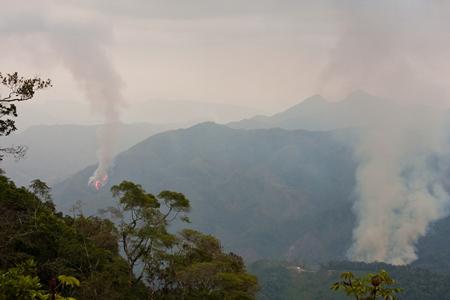Adrian Naveda-Rodriguez
To perform a biogeographic analysis and an evaluation of conservation status by means of geographic distribution of diurnal raptors of Venezuela.

Habitat destruction in the Lajas River watershed, Sierra de Perijá. Principal threat for raptors in this area is habitat conversion from forest in to croplands.
Birds are the best known vertebrate group in Venezuela due to the interest of the scientific community; nevertheless, the development of the ornithological knowledge in the country is still incipient, particularly in specific cases such as with birds of prey. The diurnal raptors of Venezuela are comprised of 68 species distributed in four families of the order Cathartiformes, Accipitriformes and Falconiformes. As are other tropical raptors species, they are confronting threatening factors such as habitat loss and destruction, environmental pollution and human persecution. Thus, conservation action is required to prevent species loss.
The natural history of diurnal raptors in Venezuela has been poorly studied, and only a few species have been subject of detailed description and analysis of their autecology; basic aspects such as species richness and geographic distribution patterns and the factors determining them, remain unstudied for most species. As a consequence of this, little is known about how the number of species varies among the biogeographic regions of Venezuela; on the other hand, the available distribution maps lack of metadata and incur in omission/commission errors.
The deficiency of knowledge of the natural history of birds of prey does not allow the correct assessment of the conservation status, as well as the design and implementation of effective conservation strategies which require sound scientific evidence based in a number of biological factors. In an attempt to fill this gap, this project will address the efforts by: (1) describing the geographic distribution of diurnal raptors, (2) describing patterns of species richness, (3) determining the environmental variables that shape the geographic distribution and species richness patterns, (4) assessing the current conservation status of diurnal raptors in Venezuela.
By means of ecological niche modelling, the geographic distribution (SDM) of 68 species of diurnal raptors will be described. Nine climatic and seven landscape metrics are used as environmental predictors. In a GIS environment the extent of occurrence (EOO) will be estimated for each species using the minimum presence training threshold. SDM will be stacked to examine species richness (S) patterns. Predictors of S will be investigated using a regression model. The EOO will be used to re-evaluate the conservation status of diurnal raptors in Venezuela, applying the criterion B1 of the IUCN Red List. Furthermore, a gap analysis will be performed to evaluate the effectiveness of strict protected areas in the conservation of raptor diversity.